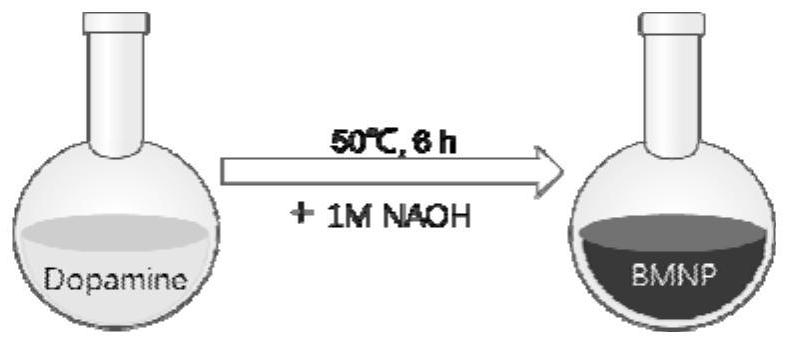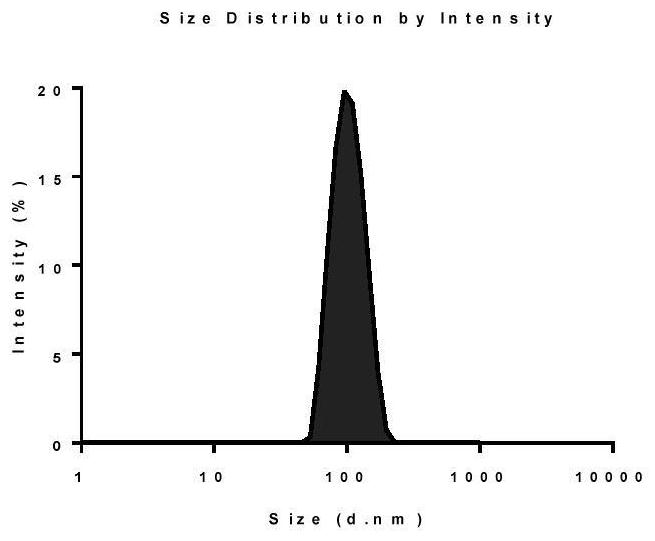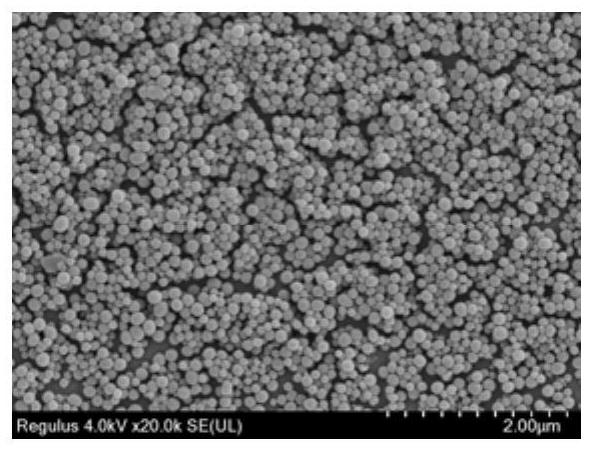Application of BMNP in protecting intestinal tract from ionizing radiation injury
An ionizing radiation, intestinal technology, applied in the biological field, can solve problems such as deficiency and intestinal damage, achieve good protection, protect radiation damage, and maintain intestinal homeostasis and function.
- Summary
- Abstract
- Description
- Claims
- Application Information
AI Technical Summary
Problems solved by technology
Method used
Image
Examples
Embodiment 1
[0103] Synthesis and characterization of embodiment 1 BMNP
[0104] BMNPs are readily prepared by oxidation and self-polymerization of dopamine under alkaline conditions ( Figure 1A ). The color of the reaction solution ranges from transparent to light yellow to dark brown. DLS data show that the average hydrodynamic particle size of BMNP is 210.3nm ( Figure 1B ), the polydispersity index is 0.074. The zeta potential of BMNP is -18.9mV ( Figure 1I ), which is essential to maintain good colloidal dispersion stability. Representative SEM and TEM images such as Figure 1C and Figure 1D As shown, the prepared BMNP is spherical, with good dispersion, uniform shape, compact structure, and a diameter between 107 and 183 nm. The elemental analysis of BMNP shows that the carbon atom rate accounts for 75.43%, the oxygen atom rate accounts for 18.07%, and the silicon atom rate accounts for 6.5% ( Figure 1E ). These results indicated that the preparation of BMNPs was successf...
Embodiment 2
[0105] Example 2 BMNP can improve the survival rate of mice after TBI and reduce intestinal damage
[0106] To evaluate the radioprotective effect of BMNP on lethally irradiated mice, 5 mg / kg BMNP was administered orally 24 h and 2 h before TBI ( Figure 2A ), and the mice were monitored for up to 30 days. All the mice in the IR group died within 11 days, while 2 mice in the IR+BMNP group survived to 30 days, the survival rate was significantly increased to 20%, and the average survival time after TBI increased from 6 days (IR group) to 10.2 days (IR+BMNP group )( Figure 2B ). Similarly, we treated mice with 15Gy ABI, compared with BMNP-treated group (IR+BMNP group;) ( Figure 2F ). After irradiation, the intestinal villi may be damaged and shortened to varying degrees. To determine the protective role of BMNP against radiation injury in the mouse gut, we investigated general changes in the mouse gut. 3 days after irradiation, IR reduced the contents of the intestines, ...
Embodiment 3
[0107] Example 3 BMNP protects intestinal function after TBI
[0108] Stool shape and quantity are important indicators for judging intestinal function. We observed changes in stool morphology, quantity and weight after irradiation. The feces of the IR group changed significantly ( Figure 3A ), the amount of feces at 0, 1, 3, and 7 days ( Figure 3B ) and weight ( Figure 3C )gradually decreases. Although the amount of feces also decreased in the BMNP-administered group, there was little difference in the overall amount. Serum FITC-D has been used as an indicator of intestinal paracellular permeability. Compared with IR group ( Figure 3D ), BMNP treatment significantly reduced the uptake of FITC-D in serum. In addition, DAO in serum is generally regarded as an indirect indicator of intestinal permeability, which further confirms that BMNP can maintain normal intestinal barrier function ( Figure 3D ). Immunohistochemical analysis of mouse intestinal tight junction p...
PUM
| Property | Measurement | Unit |
|---|---|---|
| The average particle size | aaaaa | aaaaa |
| Particle size | aaaaa | aaaaa |
| Diameter | aaaaa | aaaaa |
Abstract
Description
Claims
Application Information
 Login to View More
Login to View More - R&D
- Intellectual Property
- Life Sciences
- Materials
- Tech Scout
- Unparalleled Data Quality
- Higher Quality Content
- 60% Fewer Hallucinations
Browse by: Latest US Patents, China's latest patents, Technical Efficacy Thesaurus, Application Domain, Technology Topic, Popular Technical Reports.
© 2025 PatSnap. All rights reserved.Legal|Privacy policy|Modern Slavery Act Transparency Statement|Sitemap|About US| Contact US: help@patsnap.com



